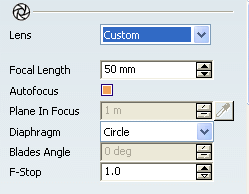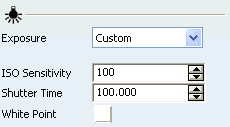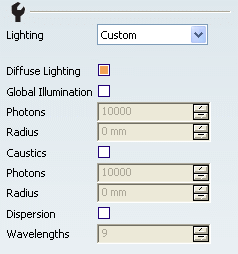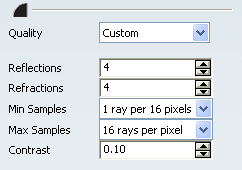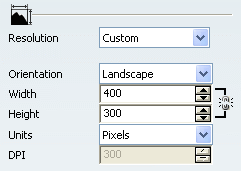About Rendering Options | ||
| ||
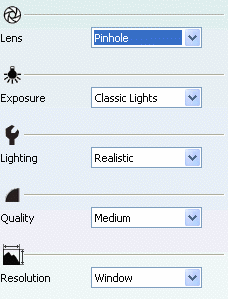
Lens
- Lens List
- You can choose one of the Using Rendering Options as lens type from the list.
- Focal Length
- The value chosen by using the Up or Down arrows defines the focal length of the lens.
- Focus
-
The following options help you to define the focus of the lens.
- Autofocus
- The focus is screen centered when the option is activated.
- Plane in Focus
-
The value chosen by using the Up or Down arrows
helps you to define the distance of plane in focus.
Important: This option is only available if Autofocus is not activated. -
Selector

-
The option lets you define manually the focus.
Important: This option is only available if Autofocus is not activated.
- Diaphragm List
The following options help you to define the diaphragm of the lens.
- Circle
Note: This option is set as default value for the option.
- 5 blades
- 6 blades
- 7 blades
- 8 blades.
- Circle
- Blades angle
- The value chosen by using the Up and Down arrows helps you to define the position of the blades.
Important: You can only select a value if you chose 5, 6, 7 or 8 blades for the diaphragm. - F-Stop
- The value chosen by using the Up and Down arrows helps you to define the diaphragm aperture.
![]()
Exposure
- Exposure List
- You can choose one of the Using Rendering Options as exposure type from the list.
- Iso Sensitivity
- The value chosen by using the Up and Down arrows helps you to define the ISO sensitivity.
- Shutter Time
- The value chosen by using the Up and Down arrows helps you to define the Shutter Time.
- White Point
Click
 to choose a color.
to choose a color.
![]()
Lighting
- Lighting List
- You can choose one of the Using Rendering Options as lighting type from the list.
- Diffuse Lighting
- Selecting this option enables you to have a rendering with a diffuse lighting.
- Global Illumination
-
When activating this option, the following ones are available:
- Photons: Using the Up or Down arrows helps you to define the photons for the global illumination.
- Radius: Using the Up or Down arrows helps you to define the radius for the global illumination.
- Caustics
-
When activating this option, the following ones are available:
- Photons: Using the Up or Down arrows helps you to define the photons for the caustics.
- Radius: Using the Up or Down arrows helps you to define the radius for the caustics.
- Dispersion
-
When activating this option, the following one is available:
- Wavelengths: Using the Up or Down arrows helps you to define the wavelengths for the dispersion.
- Radius: Using the Up or Down arrows helps you to define the radius for the caustics.
![]()
Quality
- Quality List
- You can choose one of the Using Rendering Options as quality type from the list.
- Reflections
- The value chosen by using the Up and Down arrows helps you to define the reflection depth for the quality.
- Refractions
- The value chosen by using the Up and Down arrows helps you to define the refraction depth for the quality.
- Min Samples
- The value chosen by using the Up and Down arrows helps you to define the anti-aliasing min samples for the quality.
- Max Samples
- The value chosen by using the Up and Down arrows helps you to define the anti-aliasing max samples for the quality.
- Contrast
- The value chosen by using the Up and Down arrows helps you to define the anti-aliasing contrast for the quality.
![]()
Resolution
- Resolution List
- You can choose one of the Using Rendering Options as resolution type from the list.
- Orientation
-
The following options help you to define the layout for the resolution.
- Portrait
- The resolution is of a portrait format.
- Landscape
- The resolution is of a landscape format.
- Width
- The value chosen by using the Up and Down arrows helps you to define the width for the resolution.
- Height
-
The value chosen by using the Up and Down arrows helps you to define the height for the resolution.
Tips: - If the Keep Image Ratio is open
 , you can change the width and the height values independently. The image ratio is not kept
, you can change the width and the height values independently. The image ratio is not kept - If the Keep Image Ratio is closed
 , the values you give to the width or the height parameters change simultaneously in order to keep the image ratio.
, the values you give to the width or the height parameters change simultaneously in order to keep the image ratio.
- If the Keep Image Ratio is open
- Units
-
You can choose one of the following options as the unit for the resolution:
- Pixels
Note: This option is set as default value for the option.
- cm
- mm
- Inches
- Pixels
- DPI
-
The value chosen by using the Up and Down arrows helps you to define the DPI for the resolution.
Important: This option is not available when Pixels is chosen as the unit for the resolution.
